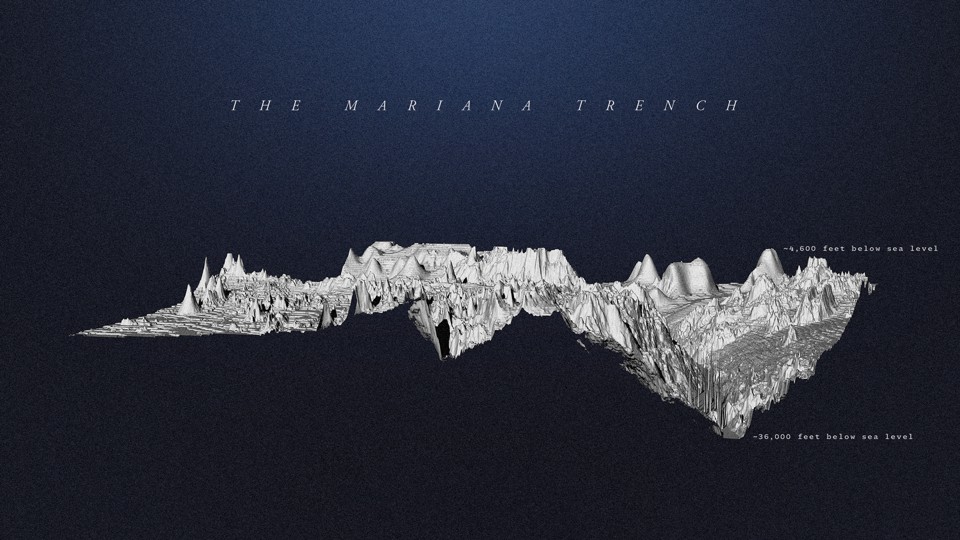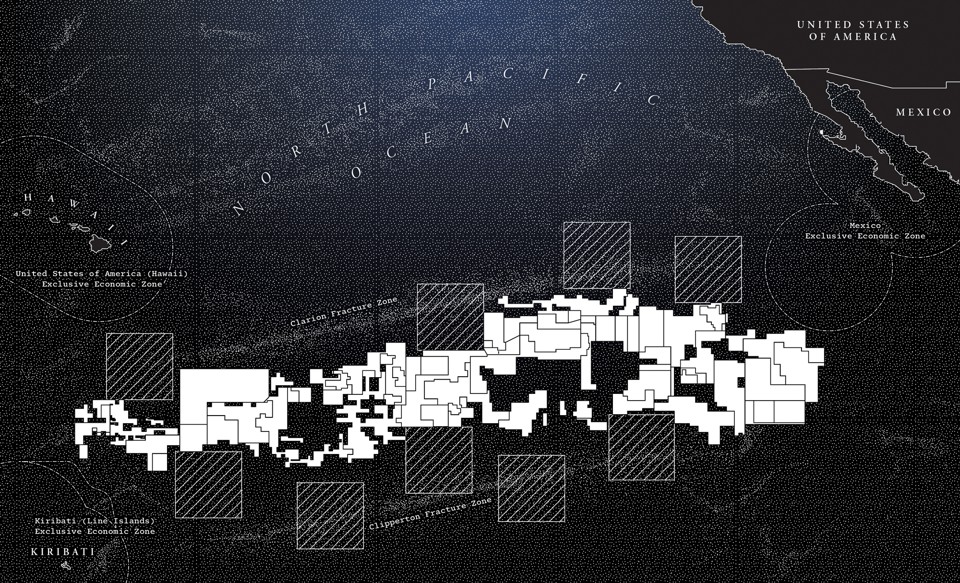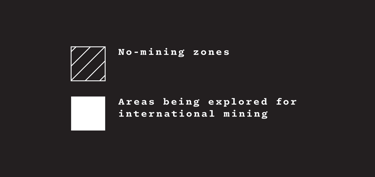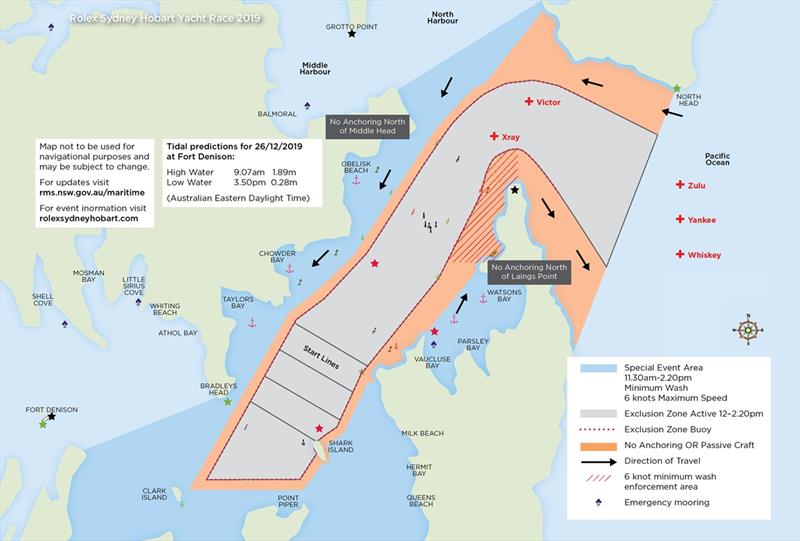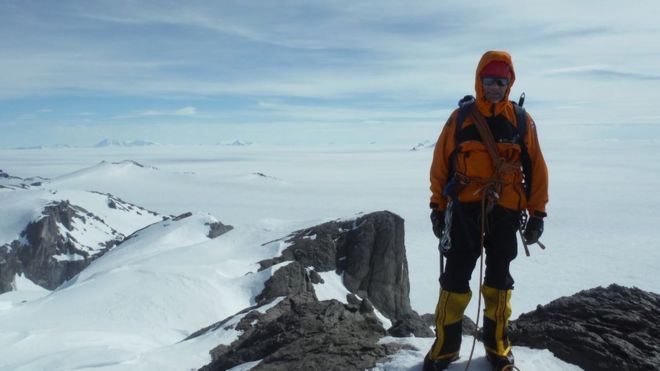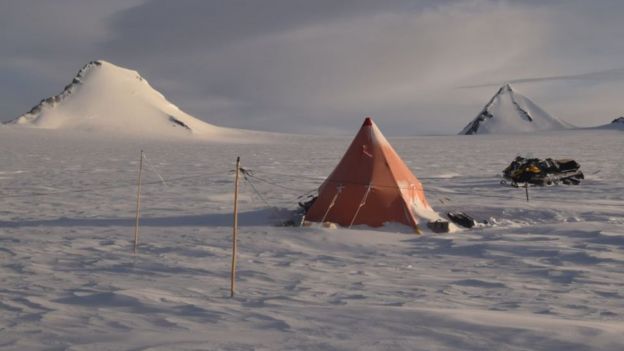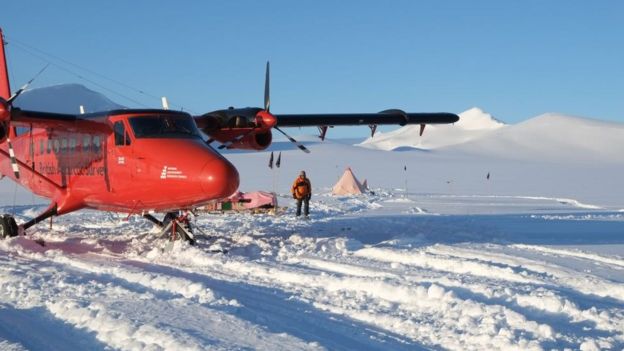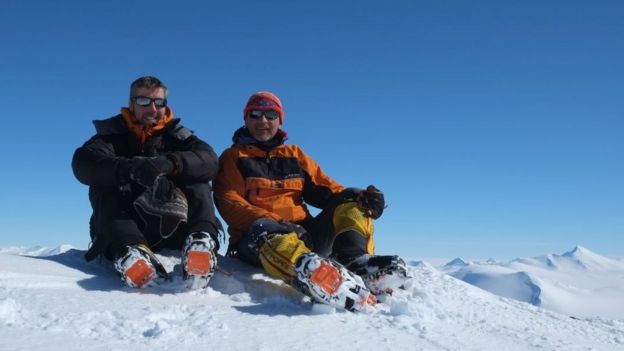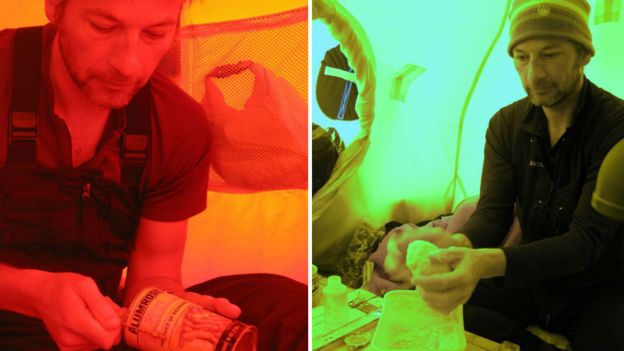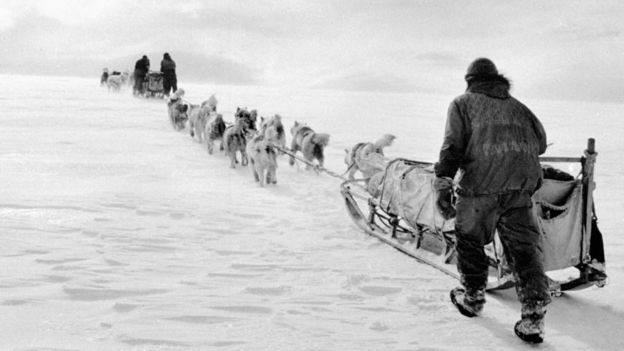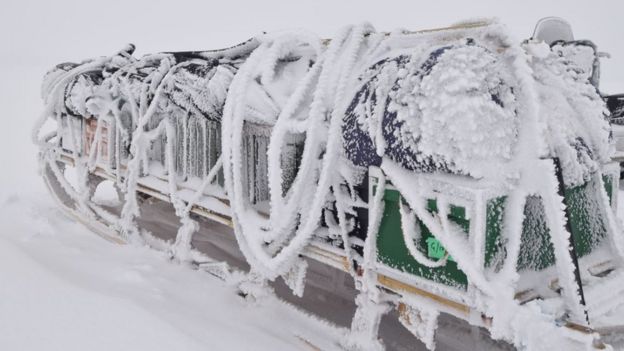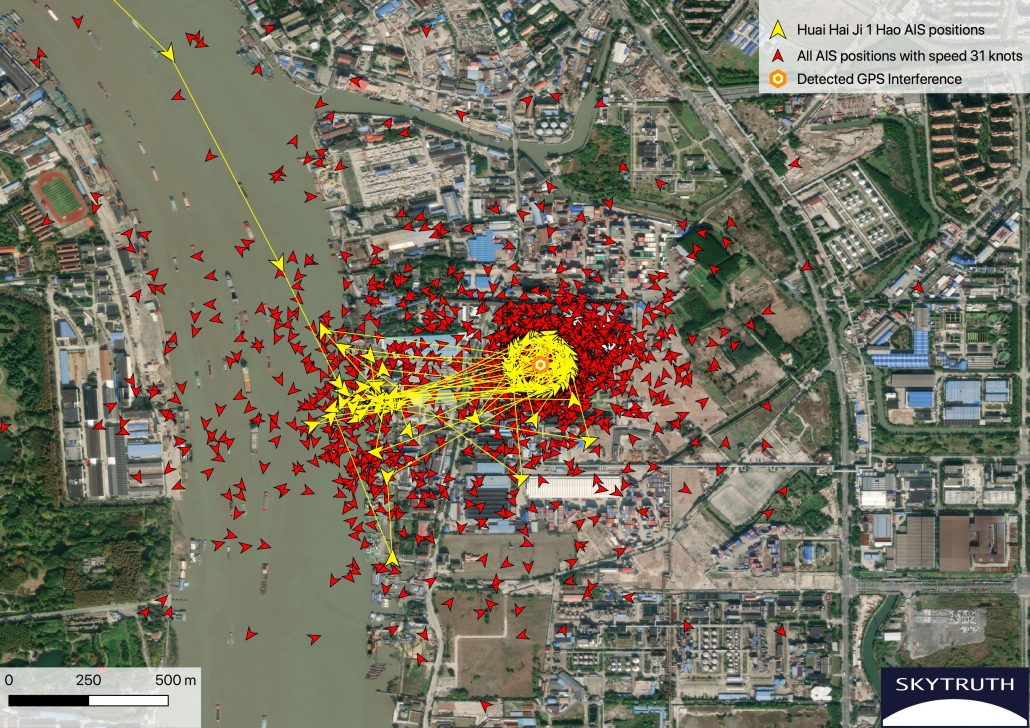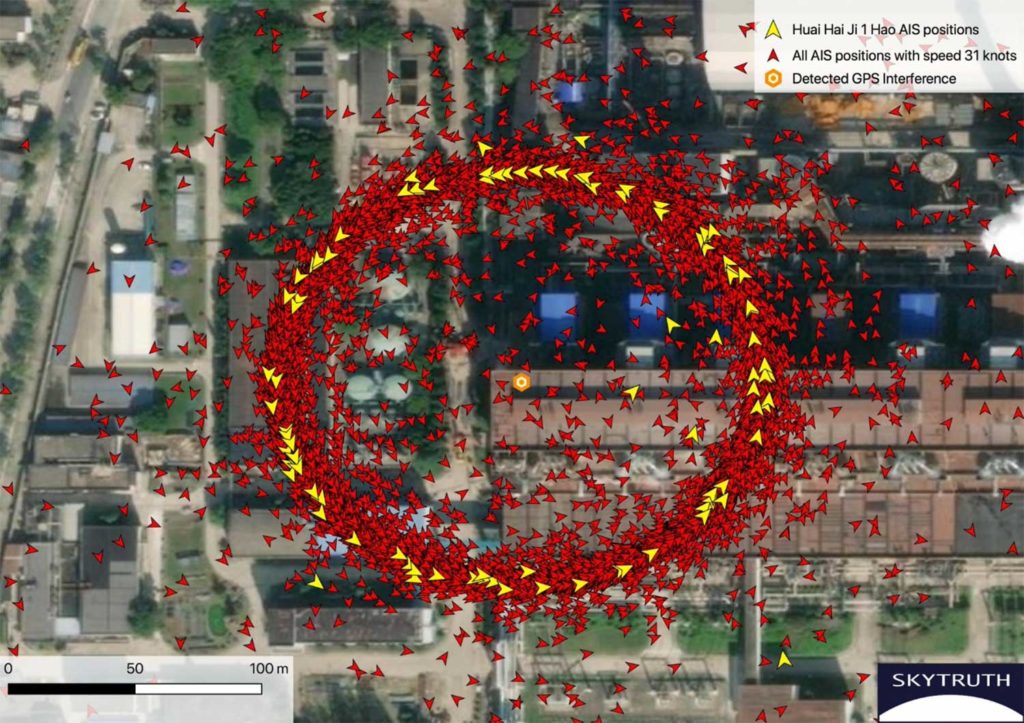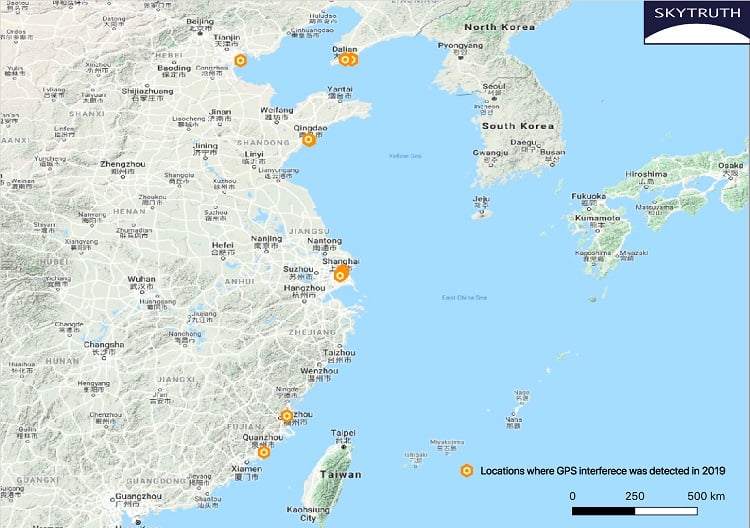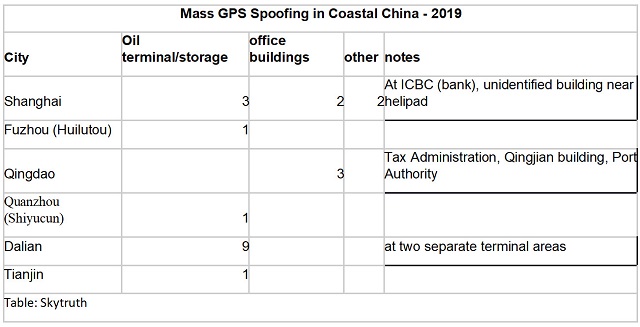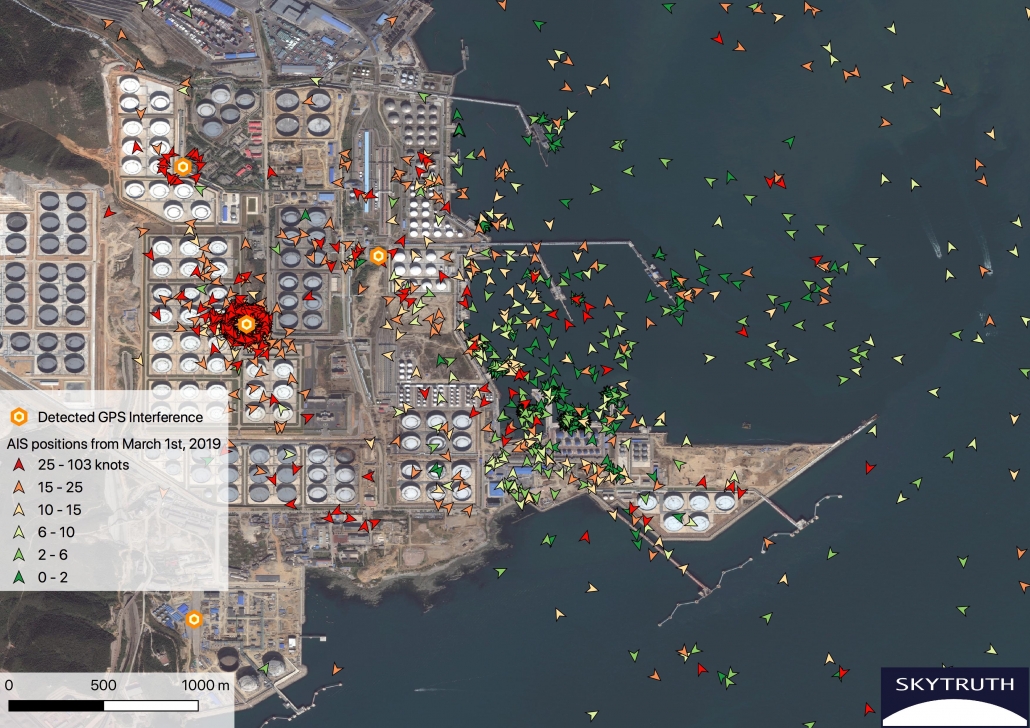Benjamin Sanchis and Miky Picon surfing on November 18th, South Landes
Saturday, December 28, 2019
Friday, December 27, 2019
History’s largest mining operation is about to begin
photo : Elicia Edijanto
From The Atlantic by Wil S. Hylton
It’s underwater—and the consequences are unimaginable.
Unless you are given to chronic anxiety or suffer from nihilistic despair, you probably haven’t spent much time contemplating the bottom of the ocean.
Many people imagine the seabed to be a vast expanse of sand, but it’s a jagged and dynamic landscape with as much variation as any place onshore.
Mountains surge from underwater plains, canyons slice miles deep, hot springs billow through fissures in rock, and streams of heavy brine ooze down hillsides, pooling into undersea lakes.
These peaks and valleys are laced with most of the same minerals found on land.
Scientists have documented their deposits since at least 1868, when a dredging ship pulled a chunk of iron ore from the seabed north of Russia.
Five years later, another ship found similar nuggets at the bottom of the Atlantic, and two years after that, it discovered a field of the same objects in the Pacific.
For more than a century, oceanographers continued to identify new minerals on the seafloor—copper, nickel, silver, platinum, gold, and even gemstones—while mining companies searched for a practical way to dig them up.
Deep Sea Mining with machines such as these would destroy large areas of the Ocean floor
Today, many of the largest mineral corporations in the world have launched underwater mining programs.
On the west coast of Africa, the De Beers Group is using a fleet of specialized ships to drag machinery across the seabed in search of diamonds.
In 2018, those ships extracted 1.4 million carats from the coastal waters of Namibia; in 2019, De Beers commissioned a new ship that will scrape the bottom twice as quickly as any other vessel.
Another company, Nautilus Minerals, is working in the territorial waters of Papua New Guinea to shatter a field of underwater hot springs lined with precious metals, while Japan and South Korea have embarked on national projects to exploit their own offshore deposits.
But the biggest prize for mining companies will be access to international waters, which cover more than half of the global seafloor and contain more valuable minerals than all the continents combined.
Regulations for ocean mining have never been formally established.
The United Nations has given that task to an obscure organization known as the International Seabed Authority, which is housed in a pair of drab gray office buildings at the edge of Kingston Harbour, in Jamaica.
Unlike most UN bodies, the ISA receives little oversight.
It is classified as “autonomous” and falls under the direction of its own secretary general, who convenes his own general assembly once a year, at the ISA headquarters.
For about a week, delegates from 168 member states pour into Kingston from around the world, gathering at a broad semicircle of desks in the auditorium of the Jamaica Conference Centre.
Their assignment is not to prevent mining on the seafloor but to mitigate its damage—selecting locations where extraction will be permitted, issuing licenses to mining companies, and drafting the technical and environmental standards of an underwater Mining Code.
Writing the code has been difficult.
ISA members have struggled to agree on a regulatory framework.
While they debate the minutiae of waste disposal and ecological preservation, the ISA has granted “exploratory” permits around the world.
Some 30 mineral contractors already hold licenses to work in sweeping regions of the Atlantic, Pacific, and Indian Oceans.
One site, about 2,300 miles east of Florida, contains the largest system of underwater hot springs ever discovered, a ghostly landscape of towering white spires that scientists call the “Lost City.” Another extends across 4,500 miles of the Pacific, or roughly a fifth of the circumference of the planet.
The companies with permits to explore these regions have raised breathtaking sums of venture capital.
They have designed and built experimental vehicles, lowered them to the bottom, and begun testing methods of dredging and extraction while they wait for the ISA to complete the Mining Code and open the floodgates to commercial extraction.
Mining companies want access to the seabed beneath international waters, which contain more valuable minerals than all the continents combined.
At full capacity, these companies expect to dredge thousands of square miles a year.
Their collection vehicles will creep across the bottom in systematic rows, scraping through the top five inches of the ocean floor.
Ships above will draw thousands of pounds of sediment through a hose to the surface, remove the metallic objects, known as polymetallic nodules, and then flush the rest back into the water.
Some of that slurry will contain toxins such as mercury and lead, which could poison the surrounding ocean for hundreds of miles.
The rest will drift in the current until it settles in nearby ecosystems.
An early study by the Royal Swedish Academy of Sciences predicted that each mining ship will release about 2 million cubic feet of discharge every day, enough to fill a freight train that is 16 miles long.
The authors called this “a conservative estimate,” since other projections had been three times as high.
By any measure, they concluded, “a very large area will be blanketed by sediment to such an extent that many animals will not be able to cope with the impact and whole communities will be severely affected by the loss of individuals and species.”
At the ISA meeting in 2019, delegates gathered to review a draft of the code.
Officials hoped the document would be ratified for implementation in 2020.
I flew down to observe the proceedings on a balmy morning and found the conference center teeming with delegates.
A staff member ushered me through a maze of corridors to meet the secretary general, Michael Lodge, a lean British man in his 50s with cropped hair and a genial smile.
He waved me toward a pair of armchairs beside a bank of windows overlooking the harbor, and we sat down to discuss the Mining Code, what it will permit and prohibit, and why the United Nations is preparing to mobilize the largest mining operation in the history of the world.
Until recently, marine biologists paid little attention to the deep sea.
They believed its craggy knolls and bluffs were essentially barren.
The traditional model of life on Earth relies on photosynthesis: plants on land and in shallow water harness sunlight to grow biomass, which is devoured by creatures small and large, up the food chain to Sunday dinner.
By this account, every animal on the planet would depend on plants to capture solar energy.
Since plants disappear a few hundred feet below sea level, and everything goes dark a little farther down, there was no reason to expect a thriving ecosystem in the deep.
Maybe a light snow of organic debris would trickle from the surface, but it would be enough to sustain only a few wayward aquatic drifters.
That theory capsized in 1977, when a pair of oceanographers began poking around the Pacific in a submersible vehicle.
While exploring a range of underwater mountains near the Galápagos Islands, they spotted a hydrothermal vent about 8,000 feet deep.
No one had ever seen an underwater hot spring before, though geologists suspected they might exist.
As the oceanographers drew close to the vent, they made an even more startling discovery: A large congregation of animals was camped around the vent opening.
These were not the feeble scavengers that one expected so far down.
They were giant clams, purple octopuses, white crabs, and 10-foot tube worms, whose food chain began not with plants but with organic chemicals floating in the warm vent water.
For biologists, this was more than curious.
It shook the foundation of their field.
If a complex ecosystem could emerge in a landscape devoid of plants, evolution must be more than a heliological affair.
Life could appear in perfect darkness, in blistering heat and a broth of noxious compounds—an environment that would extinguish every known creature on Earth.
“That was the discovery event,” an evolutionary biologist named Timothy Shank told me.
“It changed our view about the boundaries of life.
Now we know that the methane lakes on one of Jupiter’s moons are probably laden with species, and there is no doubt life on other planetary bodies.”
Shank was 12 years old that winter, a bookish kid in North Carolina.
The early romance of the space age was already beginning to fade, but the discovery of life near hydrothermal vents would inspire a blossoming of oceanography that captured his imagination.
As he completed a degree in marine biology, then a doctorate in ecology and evolution, he consumed reports from scientists around the world who found new vents brimming with unknown species.
They appeared far below the surface—the deepest known vent is about three miles down—while another geologic feature, known as a “cold seep,” gives rise to life in chemical pools even deeper on the seafloor.
No one knew how far down the vents and seeps might be found, but Shank decided to focus his research on the deepest waters of the Earth.
Scientists divide the ocean into five layers of depth.
Closest to the surface is the “sunlight zone,” where plants thrive; then comes the “twilight zone,” where darkness falls; next is the “midnight zone,” where some creatures generate their own light; and then there’s a frozen flatland known simply as “the abyss.” Oceanographers have visited these layers in submersible vehicles for half a century, but the final layer is difficult to reach.
It is known as the “hadal zone,” in reference to Hades, the ancient Greek god of the underworld, and it includes any water that is at least 6,000 meters below the surface—or, in a more Vernian formulation, that is 20,000 feet under the sea.
Because the hadal zone is so deep, it is usually associated with ocean trenches, but several deepwater plains have sections that cross into hadal depth.
Deepwater plains are also home to the polymetallic nodules that explorers first discovered a century and a half ago.
Mineral companies believe that nodules will be easier to mine than other seabed deposits.
To remove the metal from a hydrothermal vent or an underwater mountain, they will have to shatter rock in a manner similar to land-based extraction.
Nodules are isolated chunks of rocks on the seabed that typically range from the size of a golf ball to that of a grapefruit, so they can be lifted from the sediment with relative ease.
Nodules also contain a distinct combination of minerals.
While vents and ridges are flecked with precious metal, such as silver and gold, the primary metals in nodules are copper, manganese, nickel, and cobalt—crucial materials in modern batteries.
As iPhones and laptops and electric vehicles spike demand for those metals, many people believe that nodules are the best way to migrate from fossil fuels to battery power.
The ISA has issued more mining licenses for nodules than for any other seabed deposit.
Most of these licenses authorize contractors to exploit a single deepwater plain.
Known as the Clarion-Clipperton Zone, or CCZ, it extends across 1.7 million square miles between Hawaii and Mexico—wider than the continental United States.
When the Mining Code is approved, more than a dozen companies will accelerate their explorations in the CCZ to industrial-scale extraction.
Their ships and robots will use vacuum hoses to suck nodules and sediment from the seafloor, extracting the metal and dumping the rest into the water.
How many ecosystems will be covered by that sediment is impossible to predict.
Ocean currents fluctuate regularly in speed and direction, so identical plumes of slurry will travel different distances, in different directions, on different days.
The impact of a sediment plume also depends on how it is released.
Slurry that is dumped near the surface will drift farther than slurry pumped back to the bottom.
The circulating draft of the Mining Code does not specify a depth of discharge.
The ISA has adopted an estimate that sediment dumped near the surface will travel no more than 62 miles from the point of release, but many experts believe the slurry could travel farther.
A recent survey of academic research compiled by Greenpeace concluded that mining waste “could travel hundreds or even thousands of kilometers.”
Like many deepwater plains, the CCZ has sections that lie at hadal depth.
Its eastern boundary is marked by a hadal trench.
No one knows whether mining sediment will drift into the hadal zone.
As the director of a hadal-research program at the Woods Hole Oceanographic Institution, in Massachusetts, Timothy Shank has been studying the deep sea for almost 30 years.
In 2014, he led an international mission to complete the first systematic study of the hadal ecosystem—but even Shank has no idea how mining could affect the hadal zone, because he still has no idea what it contains.
If you want a sense of how little we know about the deep ocean, how difficult it is to study, and what’s at stake when industry leaps before science, Shank’s research is a good place to start.
I first met shank about seven years ago, when he was organizing the international mission to survey the hadal zone.
He had put together a three-year plan to visit every ocean trench: sending a robotic vehicle to explore their features, record every contour of topography, and collect specimens from each.
The idea was either dazzling or delusional; I wasn’t sure which.
Scientists have enough trouble measuring the seabed in shallower waters.
They have used ropes and chains and acoustic instruments to record depth for more than a century, yet 85 percent of the global seabed remains unmapped—and the hadal is far more difficult to map than other regions, since it’s nearly impossible to see.
If it strikes you as peculiar that modern vehicles cannot penetrate the deepest ocean, take a moment to imagine what it means to navigate six or seven miles below the surface.
Every 33 feet of depth exerts as much pressure as the atmosphere of the Earth, so when you are just 66 feet down, you are under three times as much pressure as a person on land, and when you are 300 feet down, you’re subjected to 10 atmospheres of pressure.
Tube worms living beside hydrothermal vents near the Galápagos are compressed by about 250 atmospheres, and mining vehicles in the CCZ have to endure twice as much—but they are still just half as far down as the deepest trenches.
Building a vehicle to function at 36,000 feet, under 2 million pounds of pressure per square foot, is a task of interstellar-type engineering.
It’s a good deal more rigorous than, say, bolting together a rover to skitter across Mars.
Picture the schematic of an iPhone case that can be smashed with a sledgehammer more or less constantly, from every angle at once, without a trace of damage, and you’re in the ballpark—or just consider the fact that more people have walked on the moon than have reached the bottom of the Mariana Trench, the deepest place on Earth.
The first two people descended in 1960, using a contraption owned by the U.S. Navy.
It seized and shuddered on the descent.
Its window cracked as the pressure mounted, and it landed with so much force that it kicked up a cloud of silt that obscured the view for the entire 20 minutes the pair remained on the bottom.
Half a century passed before the film director James Cameron repeated their journey, in 2012.
Unlike the swaggering billionaire Richard Branson, who was planning to dive the Mariana in a cartoonish vehicle shaped like a fighter jet, Cameron is well versed in ocean science and engineering.
He was closely involved in the design of his submarine, and sacrificed stylistic flourishes for genuine innovations, including a new type of foam that maintains buoyancy at full ocean depth.
Even so, his vessel lurched and bucked on the way down.
He finally managed to land, and spent a couple of hours collecting sediment samples before he noticed that hydraulic fluid was leaking onto the window.
The vehicle’s mechanical arm began to fail, and all of the thrusters on its right side went out—so he returned to the surface early, canceled his plan for additional dives, and donated the broken sub to Woods Hole.
A 3-D model of the Mariana Trench
A 3-D model of the Mariana Trench, the deepest place on Earth.
Most of what we know about its topography has been gathered by sonar.
Only three crewed expeditions have reached the bottom.
(Data Design Co)
The most recent descent of the Mariana Trench was completed last spring by a private-equity investor named Victor Vescovo, who spent $48 million on a submarine that was even more sophisticated than Cameron’s.
Vescovo was on a personal quest to reach the bottom of the five deepest trenches in the world, a project he called “Five Deeps.” He was able to complete the project, making multiple dives of the Mariana—but if his achievement represents a leap forward in hadal exploration, it also serves as a reminder of how impenetrable the trenches remain: a region that can be visited only by the most committed multimillionaire, Hollywood celebrity, or special military program, and only in isolated dives to specific locations that reveal little about the rest of the hadal environment.
That environment is composed of 33 trenches and 13 shallower formations called troughs.
Its total geographic area is about two-thirds the size of Australia.
It is the least examined ecosystem of its size on Earth.
Without a vehicle to explore the hadal zone, scientists have been forced to use primitive methods.
The most common technique has scarcely changed in more than a century: Expedition ships chug across hundreds of miles to reach a precise location, then lower a trap, wait a few hours, and reel it up to see what’s inside.
The limitations of this approach are self-evident, if not comic.
It’s like dangling a birdcage out the door of an airplane crossing Africa at 36,000 feet, and then trying to divine, from the mangled bodies of insects, what sort of animals roam the savanna.
All of which is to say that Shank’s plan to explore every trench in the world was somewhere between audacious and absurd, but he had assembled a team of the world’s leading experts, secured ship time for extensive missions, and spent 10 years supervising the design of the most advanced robotic vehicle ever developed for deepwater navigation.
Called Nereus, after a mythological sea god, it could dive alone—charting a course amid rocky cliffs, measuring their contours with a doppler scanner, recording video with high-definition cameras, and collecting samples—or it could be linked to the deck of a ship with fiber-optic cable, allowing Shank to monitor its movement on a computer in the ship’s control room, boosting the thrusters to steer this way and that, piercing the darkness with its headlamps, and maneuvering a mechanical claw to gather samples in the deep.
I reached out to Shank in 2013, a few months before the expedition began.
I wanted to write about the project, and he agreed to let me join him on a later leg.
When his ship departed, in the spring of 2014, I followed online as it pursued a course to the Kermadec Trench, in the Pacific, and Shank began sending Nereus on a series of dives.
On the first, it descended to 6,000 meters, a modest target on the boundary of the hadal zone.
On the second, Shank pushed it to 7,000 meters; on the third to 8,000; and on the fourth to 9,000.
He knew that diving to 10,000 meters would be a crucial threshold.
It is the last full kilometer of depth on Earth: No trench is believed to be deeper than 11,000 meters.
To commemorate this final increment and the successful beginning of his project, he attached a pair of silver bracelets to the frame of Nereus, planning to give them to his daughters when he returned home.
Then he dropped the robot in the water and retreated to the control room to monitor its movements.
On-screen, blue water gave way to darkness as Nereus descended, its headlamps illuminating specks of debris suspended in the water.
It was 10 meters shy of the 10,000-meter mark when suddenly the screen went dark.
There was an audible gasp in the control room, but no one panicked.
Losing the video feed on a dive was relatively common.
Maybe the fiber-optic tether had snapped, or the software had hit a glitch.
Whatever it was, Nereus had been programmed to respond with emergency measures.
It could back out of a jam, shed expendable weight, guide itself to the surface, and send a homing beacon to help Shank’s team retrieve it.
As the minutes ticked by, Shank waited for those measures to activate, but none did.
“There’s no sound, no implosion, no chime,” he told me afterward.
“Just … black.” He paced the deck through the night, staring across the Stygian void for signs of Nereus.
The following day he finally saw debris surface, and as he watched it rise, he felt his project sinking.
Ten years of planning, a $14 million robot, and an international team of experts—it had all collapsed under the crushing pressure of hadal depths.
“I’m not over it yet,” he told me two years later.“I think we’ll be looking at hundreds or thousands of species we haven’t seen before, and some of them are going to be huge.”
We were standing on the deck of another ship, 100 miles off the coast of Massachusetts, where Shank was preparing to launch a new robot.
The vehicle was no replacement for Nereus.
It was a rectilinear hunk of metal and plastic, about five feet high, three feet wide, and nine feet long.
Red on top, with a silvery bottom and three fans mounted at the rear, it could have been mistaken for a child’s backyard spaceship.
Shank had no illusion that it was capable of hadal exploration.
Since the loss of Nereus, there was no vehicle on Earth that could navigate the deepest trenches—Cameron’s was no longer in service, Branson’s didn’t work, and Vescovo’s hadn’t yet been built.
Shank’s new robot did have a few impressive features.
Its navigational system was even more advanced than the one in Nereus, and he hoped it would be able to maneuver in a trenchlike environment with even greater precision—but its body was not designed to withstand hadal pressure.
In fact, it had never descended more than a few dozen feet below the surface, and Shank knew that it would take years to build something that could survive at the bottom of a trench.
What had seemed, just two years earlier, like the beginning of a new era in hadal science was developing a quixotic aspect, and, at 50, Shank could not help wondering if it was madness to spend another decade of his life on a dream that seemed to be drifting further from his reach.
But he was driven by a lifelong intuition that he still couldn’t shake.
Shank believes that access to the trenches will reveal one of the greatest discoveries in history: a secret ecosystem bursting with creatures that have been cloistered for eternity in the deep.
“I would be shocked if there aren’t vents and seeps in the trenches,” he told me as we bobbed on the water that day in 2016.
“They’ll be there, and they will be teeming with life.
I think we’ll be looking at hundreds or thousands of species we haven’t seen before, and some of them are going to be huge.” He pictured the hadal as an alien world that followed its own evolutionary course, the unimaginable pressure creating a menagerie of inconceivable beasts.
“My time is running out to find them,” he said.
“Maybe my legacy will be to push things forward so that somebody else can. We have a third of our ocean that we still can’t explore. It’s embarrassing. It’s pathetic.”
While scientists struggle to reach the deep ocean, human impact has already gotten there.
Most of us are familiar with the menu of damages to coastal water: overfishing, oil spills, and pollution, to name a few.
What can be lost in the discussion of these issues is how they reverberate far beneath.
Take fishing.
The relentless pursuit of cod in the early 20th century decimated its population from Newfoundland to New England, sending hungry shoppers in search of other options.
As shallow-water fish such as haddock, grouper, and sturgeon joined the cod’s decline, commercial fleets around the world pushed into deeper water.
Until the 1970s, the slimehead fish lived in relative obscurity, patrolling the slopes of underwater mountains in water up to 6,000 feet deep.
Then a consortium of fishermen pushed the Food and Drug Administration to change its name, and the craze for “orange roughy” began—only to fade again in the early 2000s, when the fish was on a path toward extinction itself.
Environmental damage from oil production is also migrating into deeper water.
Disturbing photographs of oil-drenched beaches have captured public attention since at least 1989, when the Exxon Valdez tanker crashed into a reef and leaked 11 million gallons into an Alaskan sound.
It would remain the largest spill in U.S.
water until 2010, when the Deepwater Horizon explosion spewed 210 million gallons into the Gulf of Mexico.
But a recent study revealed that the release of chemicals to disperse the spill was twice as toxic as the oil to animals living 3,000 feet below the surface.
Maybe the greatest alarm in recent years has followed the discovery of plastic floating in the ocean.
Scientists estimate that 17 billion pounds of polymer are flushed into the ocean each year, and substantially more of it collects on the bottom than on the surface.
Just as a bottle that falls from a picnic table will roll downhill to a gulch, trash on the seafloor gradually makes its way toward deepwater plains and hadal trenches.
After his expedition to the trenches, Victor Vescovo returned with the news that garbage had beaten him there.
He found a plastic bag at the bottom of one trench, a beverage can in another, and when he reached the deepest point in the Mariana, he watched an object with a large S on the side float past his window.
Trash of all sorts is collecting in the hadal—Spam tins, Budweiser cans, rubber gloves, even a mannequin head.
Scientists are just beginning to understand the impact of trash on aquatic life.
Fish and seabirds that mistake grocery bags for prey will glut their stomachs with debris that their digestive system can’t expel.
When a young whale drifted ashore and died in the Philippines in 2019, an autopsy revealed that its belly was packed with 88 pounds of plastic bags, nylon rope, and netting.
Two weeks later, another whale beached in Sardinia, its stomach crammed with 48 pounds of plastic dishes and tubing.
Certain types of coral like to eat plastic more than food.
They will gorge themselves like a kid on Twinkies instead of eating what they need to survive.
Microbes that flourish on plastic have ballooned in number, replacing other species as their population explodes in a polymer ocean.
If it seems trivial to worry about the population statistics of bacteria in the ocean, you may be interested to know that ocean microbes are essential to human and planetary health.
About a third of the carbon dioxide generated on land is absorbed by underwater organisms, including one species that was just discovered in the CCZ in 2018.
The researchers who found that bacterium have no idea how it removes carbon from the environment, but their findings show that it may account for up to 10 percent of the volume that is sequestered by oceans every year.
Many of the things we do know about ocean microbes, we know thanks to Craig Venter, the genetic scientist most famous for starting a small company in the 1990s to compete with the Human Genome Project.
The two-year race between his company and the international collaboration generated endless headlines and culminated in a joint announcement at the White House to declare a tie.
But Venter’s interest wasn’t limited to human DNA.
He wanted to learn the language of genetics in order to create synthetic microbes with practical features.
After his work on the human genome, he spent two years sailing around the world, lowering bottles into the ocean to collect bacteria and viruses from the water.
By the time he returned, he had discovered hundreds of thousands of new species, and his lab in Maryland proceeded to sequence their DNA—identifying more than 60 million unique genes, which is about 2,500 times the number in humans.
Then he and his team began to scour those genes for properties they could use to make custom bugs.
Venter now lives in a hypermodern house on a bluff in Southern California.
Chatting one evening on the sofa beside the door to his walk-in humidor and wine cellar, he described how saltwater microbes could help solve the most urgent problems of modern life.
One of the bacteria he pulled from the ocean consumes carbon and excretes methane.
Venter would like to integrate its genes into organisms designed to live in smokestacks and recycle emissions.
“They could scrub the plant’s CO2 and convert it to methane that can be burned as fuel in the same plant,” he said.
Venter was also studying bacteria that could be useful in medicine.
Microbes produce a variety of antibiotic compounds, which they deploy as weapons against their rivals.
Many of those compounds can also be used to kill
Nearly all of the antibiotic drugs on the market were initially derived from microorganisms, but they are losing efficacy as pathogens evolve to resist them.
“We have new drugs in development,” Matt McCarthy, an infectious-disease specialist at Weill Cornell Medical College, told me, “but most of them are slight variations on the ones we already had.
The problem with that is, they’re easy for bacteria to resist, because they’re similar to something bacteria have developed resistance to in the past.
What we need is an arsenal of new compounds.”
Venter pointed out that ocean microbes produce radically different compounds from those on land.
“There are more than a million microbes per milliliter of seawater,” he said, “so the chance of finding new antibiotics in the marine environment is high.” McCarthy agreed.
“The next great drug may be hidden somewhere deep in the water,” he said.
“We need to get to the deep-sea organisms, because they’re making compounds that we’ve never seen before.
We may find drugs that could be used to treat gout, or rheumatoid arthritis, or all kinds of other conditions.”
Marine biologists have never conducted a comprehensive survey of microbes in the hadal trenches.
The conventional tools of water sampling cannot function at extreme depth, and engineers are just beginning to develop tools that can.
Microbial studies of the deepwater plains are slightly further along—and scientists have recently discovered that the CCZ is unusually flush with life.
“It’s one of the most biodiverse areas that we’ve ever sampled on the abyssal plains,” a University of Hawaii oceanographer named Jeff Drazen told me.
Most of those microbes, he said, live on the very same nodules that miners are planning to extract.
“When you lift them off the seafloor, you’re removing a habitat that took 10 million years to grow.” Whether or not those microbes can be found in other parts of the ocean is unknown.
“A lot of the less mobile organisms,” Drazen said, “may not be anywhere else.”
Drazen is an academic ecologist; Venter is not.
Venter has been accused of trying to privatize the human genome, and many of his critics believe his effort to create new organisms is akin to playing God.
He clearly doesn’t have an aversion to profit-driven science, and he’s not afraid to mess with nature—yet when I asked him about the prospect of mining in deep water, he flared with alarm.
“We should be very careful about mining in the ocean,” he said.
“These companies should be doing rigorous microbial surveys before they do anything else.
We only know a fraction of the microbes down there, and it’s a terrible idea to screw with them before we know what they are and what they do.”
The Clarion-Clipperton Zone is a deepwater plain wider than the continental United States.
When the Mining Code is approved, more than a dozen contractors could begin commercial extraction there.
(La Tigre)
Mining executives insist that their work in the ocean is misunderstood.
Some adopt a swaggering bravado and portray the industry as a romantic frontier adventure.
As the manager of exploration at Nautilus Minerals, John Parianos, told me recently, “This is about every man and his dog filled with the excitement of the moon landing.
It’s like Scott going to the South Pole, or the British expeditions who got entombed by ice.”
Nautilus occupies a curious place in the mining industry.
It is one of the oldest companies at work on the seafloor, but also the most precarious.
Although it has a permit from the government of Papua New Guinea to extract metal from offshore vents, many people on the nearby island of New Ireland oppose the project, which will destroy part of their marine habitat.
Local and international activists have whipped up negative publicity, driving investors away and sending the company into financial ruin.
Nautilus stock once traded for $4.45.
It is now less than a penny per share.
Parianos acknowledged that Nautilus was in crisis, but he dismissed the criticism as naive.
Seabed minerals are no different from any other natural resource, he said, and the use of natural resources is fundamental to human progress.
“Look around you: Everything that’s not grown is mined,” he told me.
“That’s why they called it the Stone Age—because it’s when they started mining! And mining is what made our lives better than what they had before the Stone Age.” Parianos emphasized that the UN Convention on the Law of the Sea, which created the International Seabed Authority, promised “to ensure effective protection for the marine environment” from the effects of mining.
“It’s not like the Law of the Sea says: Go out and ravage the marine environment,” he said.
“But it also doesn’t say that you can only explore the ocean for science, and not to make money.”
The CEO of a company called DeepGreen spoke in loftier terms.
DeepGreen is both a product of Nautilus Minerals and a reaction to it.
The company was founded in 2011 by David Heydon, who had founded Nautilus a decade earlier, and its leadership is full of former Nautilus executives and investors.
As a group, they have sought to position DeepGreen as a company whose primary interest in mining the ocean is saving the planet.
They have produced a series of lavish brochures to explain the need for a new source of battery metals, and Gerard Barron, the CEO, speaks with animated fervor about the virtues of nodule extraction.
Is there any way to calculate the value of a landscape we know virtually nothing about?His case for seabed mining is straightforward.
Barron believes that the world will not survive if we continue burning fossil fuels, and the transition to other forms of power will require a massive increase in battery production.
He points to electric cars: the batteries for a single vehicle require 187 pounds of copper, 123 pounds of nickel, and 15 pounds each of manganese and cobalt.
On a planet with 1 billion cars, the conversion to electric vehicles would require several times more metal than all existing land-based supplies—and harvesting that metal from existing sources already takes a human toll.
Most of the world’s cobalt, for example, is mined in the southeastern provinces of the Democratic Republic of Congo, where tens of thousands of young children work in labor camps, inhaling clouds of toxic dust during shifts up to 24 hours long.
Terrestrial mines for nickel and copper have their own litany of environmental harms.
Because the ISA is required to allocate some of the profits from seabed mining to developing countries, the industry will provide nations that rely on conventional mining with revenue that doesn’t inflict damage on their landscapes and people.
Whether DeepGreen represents a shift in the values of mining companies or merely a shift in marketing rhetoric is a valid question—but the company has done things that are difficult to dismiss.
It has developed technology that returns sediment discharge to the seafloor with minimal disruption, and Barron is a regular presence at ISA meetings, where he advocates for regulations to mandate low-impact discharge.
DeepGreen has also limited its operations to nodule mining, and Barron openly criticizes the effort by his friends at Nautilus to demolish a vent that is still partially active.
“The guys at Nautilus, they’re doing their thing, but I don’t think it’s the right thing for the planet,” he told me.
“We need to be doing things that have a low impact environmentally.”
By the time i sat down with Michael Lodge, the secretary general of the ISA, I had spent a lot of time thinking about the argument that executives like Barron are making.
It seemed to me that seabed mining presents an epistemological problem.
The harms of burning fossil fuels and the impact of land-based mining are beyond dispute, but the cost of plundering the ocean is impossible to know.
What creatures are yet to be found on the seafloor? How many indispensable cures? Is there any way to calculate the value of a landscape we know virtually nothing about? The world is full of uncertain choices, of course, but the contrast between options is rarely so stark: the crisis of climate change and immiserated labor on the one hand, immeasurable risk and potential on the other.
I thought of the hadal zone.
It may never be harmed by mining.
Sediment from dredging on the abyssal plains could settle long before it reaches the edge of a trench—but the total obscurity of the hadal should remind us of how little we know.
It extends from 20,000 feet below sea level to roughly 36,000 feet, leaving nearly half of the ocean’s depths beyond our reach.
When I visited Timothy Shank at Woods Hole a few months ago, he showed me a prototype of his latest robot.
He and his lead engineer, Casey Machado, had built it with foam donated by James Cameron and with support from NASA’s Jet Propulsion Laboratory, whose engineers are hoping to send a vehicle to explore the aqueous moon of Jupiter.
It was a tiny machine, known as Orpheus, that could steer through trenches, recording topography and taking samples, but little else.
He would have no way to direct its movements or monitor its progress via a video feed.
It occurred to me that if Shank had given up the dream of true exploration in the trenches, decades could pass before we know what the hadal zone contains.
Mining companies may promise to extract seabed metal with minimal damage to the surrounding environment, but to believe this requires faith.
It collides with the force of human history, the law of unintended consequences, and the inevitability of mistakes.
I wanted to understand from Michael Lodge how a UN agency had made the choice to accept that risk.
“Why is it necessary to mine the ocean?” I asked him.
He paused for a moment, furrowing his brow.
“I don’t know why you use the word necessary,” he said.
“Why is it ‘necessary’ to mine anywhere? You mine where you find metal.”
I reminded him that centuries of mining on land have exacted a devastating price: tropical islands denuded, mountaintops sheared off, groundwater contaminated, and species eradicated.
Given the devastation of land-based mining, I asked, shouldn’t we hesitate to mine the sea?
“I don’t believe people should worry that much,” he said with a shrug.
“There’s certainly an impact in the area that’s mined, because you are creating an environmental disturbance, but we can find ways to manage that.” I pointed out that the impact from sediment could travel far beyond the mining zone, and he responded, “Sure, that’s the other major environmental concern.
There is a sediment plume, and we need to manage it.
We need to understand how the plume operates, and there are experiments being done right now that will help us.”
As he spoke, I realized that for Lodge, none of these questions warranted reflection—or anyway, he didn’t see reflection as part of his job.
He was there to facilitate mining, not to question the wisdom of doing so.
We chatted for another 20 minutes, then I thanked him for his time and wandered back to the assembly room, where delegates were delivering canned speeches about marine conservation and the promise of battery technology.
There was still some debate about certain details of the Mining Code—technical requirements, oversight procedures, the profit-sharing model—so the vote to ratify it would have to wait another year.
I noticed a group of scientists watching from the back.
They were members of the Deep-Ocean Stewardship Initiative, which formed in 2013 to confront threats to the deepwater environment.
One was Jeff Drazen.
He’d flown in from Hawaii and looked tired.
I sent him a text, and we stepped outside.
A few tables and chairs were scattered in the courtyard, and we sat down to talk.
I asked how he felt about the delay of the Mining Code—delegates are planning to review it again this summer, and large-scale mining could begin after that.
Drazen rolled his eyes and sighed.
“There’s a Belgian team in the CCZ doing a component test right now,” he said.
“They’re going to drive a vehicle around on the seafloor and spew a bunch of mud up.
So these things are already happening.
We’re about to make one of the biggest transformations that humans have ever made to the surface of the planet.
We’re going to strip-mine a massive habitat, and once it’s gone, it isn’t coming back.”
Links :
Thursday, December 26, 2019
How to race the Sydney Hobart? Break it into its parts
The yacht Alive approaching Tasmania’s fabled Organ Pipes during last year’s Sydney Hobart race.
Credit... Studio Borlenghi/Rolex, via Agence France-Presse
From NYTimes by David Schmidt
Experienced sailors say not to approach it as one event, but as several.
Sailboat races have a way of developing their own lore, especially when there are boat-breaking waves and fast-moving weather systems.
It is easy to think that the annual Rolex Sydney Hobart Yacht Race, which begins on Thursday, involves just three things: the start, the spin cycle and the finish.
Race veterans say that approaching this rough-and-tumble, 628-nautical-mile racecourse as a monolith can be overwhelming.
Instead, they say, a compartmentalized mind-set is required to deal with the race’s seamanship and navigational challenges, and it is best to break the race down to segments, or chapters, planning how to handle them one at a time.
The race begins in Sydney Harbor before punching out past Sydney Heads and turning south to parallel the New South Wales coastline.
The East Australia Current, which flows generally south at one to four knots, pushes boats along, but this benefit can boomerang.
Hook into a northerly breeze, so that the wind and current align, and sailors enjoy a magic-carpet ride toward Bass Strait.
Encounter a “southerly buster,” which delivers stiff winds from the south that oppose the current, and the seas stack up.
Fast.
Hit this wind-against-current scenario in or near Bass Strait, the shallow body of water separating Australia from Tasmania, and the seas can quickly become a nautical nightmare.
This happened in 1993, when two-thirds of the fleet abandoned racing, and again in the tragic 1998 race when six sailors died and five yachts sank.
“This race is not to be underestimated,” said Will Oxley of Australia, a navigator who has won the race twice but also ended up in a life raft once.
He says the wind typically blows from the northeast for a few days before transitioning to a southerly.
“I’ve done about 350,000 miles of sailing, and my worst experiences with sea state have been in this race,” he added.
“There aren’t many races that you’d see 50 knots upwind.”
Next to be negotiated are the Tasmanian coastline, Storm Bay and the River Derwent, an upriver slog of about 11 nautical miles where the wind typically dwindles or dies each evening before rekindling the next morning.
Worse still, the tidal river usually flows seaward, pushing yachts backward.
Because of this, fortunes are often won or lost on the River Derwent.
For Oxley, who plans to race on Matt Allen’s Botin 52 Ichi Ban this year, the chapters are the start, the New South Wales coast, crossing Bass Strait, the Tasmanian coast and the 40-mile journey across Storm Bay and up the River Derwent.
Ken Read, the former skipper of Comanche, the 100-foot super maxi (now LDV Comanche) that he commanded to a line-honors win (first across the finish line) in 2015, says he does not mind racing in nasty conditions but hates anticipating them.
“If there’s one consistent thing about this race, something weird is going to happen, and you’d better be prepared,” he said.
Weather, of course, is critical.
“You definitely divide the race into chapters,” Read said.
But for him, “it’s purely weather-driven.”
Instead of geographical distinctions, Read and Stan Honey, an America’s Cup and Volvo Ocean Race-winning navigator who helped LDV Comanche set the racecourse’s time record in 2017, view the racecourse through a meteorological lens.
“It’s almost guaranteed that you’re going through a strong front that time of year,” said Read, describing the race’s chapters as the start, the prefront, the frontal transition, after a weather front passes, approaching Storm Bay and finally the River Derwent.
“I talk about one weather transition,” he said, adding that record-setting boats like Comanche can often outsail a second bad-weather cycle.
“The little boats are likely looking at two transitions, so it’s twice as hard and two to three times the exposure.”
Honey described negotiating the low-pressure systems as jaywalking across a busy highway.
Comanche sprints while the smaller boats stroll.
“If you have a tough race, you could have two to four days of a hard southwesterly bash all the way,” said Lindsay May, a Sydney native who has won the race four times.
This year’s race will be his 47th consecutive start.
“It’s a lottery and needs good understanding of the forecast to best navigate the route, plus a lot of luck.”
And luck, of course, is ephemeral.
Some Sydney Hobart sailors divide the race by geography or weather.
Others think in hours.
“This race is not to be underestimated,” said Will Oxley, a two-time winner.
Credit...Carlo Borlenghi/Rolex
“I think in segments, but they’re not the same, year to year,” Honey said.
“A common transition is the southerly change, which sees wind against the East Australia Current,” he said, describing an often-violent sea.
“The wind picks up quickly under a characteristic roll cloud — it’s a frightening sight.”
Honey described his chapters as the start, entering the offshore winds, negotiating the East Australia Current, crossing Bass Strait, approaching Tasmania, picking the best lane — or angle — toward Tasmania, crossing Storm Bay and sailing up the River Derwent.
Picking the best lane toward Tasmania can be crucial, and Honey and Oxley described it as potentially one of the race’s biggest navigational problems.
“I’m looking if the weather models line up, but typically I use historical and real-time data and my gut to make the decision,” Oxley said.
A casual weekend sail this is not.
“It’s my favorite race as a navigator, there are so many moving parts,” Honey said, before admitting that it is not always pleasant.
“In almost every other yacht race, you start and go someplace nice.
With the Sydney Hobart, you start someplace warm and nice and go someplace cold and windy.”
While some divide the race by geography or weather, others think in hours.
“In basic terms, it’s all about when you get to Storm Bay,” said Roger Badham, a meteorologist who has been preparing pre-race weather reports since 1982.
“The timing to get to Storm Bay and the Derwent is critical,” he added.
“God, in his wisdom, determines the handicap winner.”
The River Derwent “can be a long and painful exercise,” Oxley said.
“The best time to arrive in Storm Bay is in the afternoon.
The Derwent can take 45 minutes or six hours.”
Because of this, Oxley said, the race can sometimes be further simplified into two chapters: the run of 588 nautical miles to Tasman Island and the 40-nautical-mile race from Tasman Island to the finish.
While the rules preclude Badham from offering weather services once racing begins, his pre-race reports break the course into 12-hour increments.
“The current changes weekly, but the winds are changing hourly or daily,” he said.
“Initial conditions are the most important thing.”
To win, Badham said, yachts must marry periods of fast sailing with their big-picture objective of knowing when and where the wind will change, and where the boats want to be positioned relative to this transition.
“It’s primarily a near-coastal race except Bass Strait,” he said.
Wind on the rumbline, the most direct line across a body of water, “is highly influenced by land masses, day and night variation and sea-breeze effects.” Because of this, he said, it is critical to understand the influences of geography, time and weather transitions.
Ultimately, Badham said, if team leadership is not looking at the racecourse in terms of all three, odds are good that those sailors will be languishing in the River Derwent or maneuvering through a southerly buster, while others are already across the finish line.
Links :
- NYTimes : Smoke on the Water and Other Sydney Hobart Challenge / For the Sydney Hobart, an Indigenous Crew Puts to Sea
- LiveSailDie : “Comanche” with Stan Honey
- TidetechMarineData : 'Won and Lost' in the Derwent How tricky currents play a part in the closing stages of the Rolex Sydney to Hobart Race
Wednesday, December 25, 2019
Scientist spends 17th Christmas in the Antarctic
From BBC
A 40-year-old tin of bacon and vacuum-packed leftovers are among the treats a scientist has enjoyed for Christmas dinner while spending 17 festive seasons in a tent in the Antarctic.
Geologist Dr Teal Riley will spend the season under canvas with a stranger.
He stays at the British Antarctic Survey's base - more than 6,200 miles (10,000km) from his home - for months.
He said it made him realise how special Christmas is when he does get to spend it with his family.
About 150 staff work at BAS's Rothera research station at this time each year, for what is the Antarctic summer.
Dr Riley, 49, has worked for the Cambridge-based organisation for 25 years and for most of those he has missed Christmas at home with his partner and their son.
The tiny pyramid tents are made of the same tightly woven cotton used by
Scott's Antarctic expeditions in the early 20th Century
He can be dropped off up to five hours' flying time away from the main base
Instead he spends it in a small tent in temperatures up to -20C (-4F) with a polar guide - a trained mountaineer he will have met just days beforehand.
"You do end up feeding off each other's mood - and you know when to shut up," he said.
Dr Riley flew out in mid-December and expects to be there for up to three months.
Polar guide Malcolm Airey (l) was Dr Riley's Christmas tent mate in 2014
One year they tucked in to a lovely tin of 40-year-old bacon (l) they found in an old hut
He is able to contact his family via email from a satellite phone but his priority remains getting on with the research.
Fieldwork teams went everywhere by dog sleds until 1994
Most travel now takes place on snow mobiles
"If you have good weather, you work," he said.
Although one Christmas he spent three days stuck in the tent because of storms.
"That can be quite terrifying," he said.
Temperatures in the field can reach up to -20C
However, they try to make extra time for dinner when the working day is done.
"Last season we had leftover chicken which had been vacuum-packed several months before.
"One year we came across an old dog sled depot used in the 1960s or 70s and found some tins of bacon - one of them was quite reasonable, so we had that."
Dr Teal added: "I'm not a Grinch, so it really does make Christmas feel much more special when I can actually be at home with my family."
Links :
Tuesday, December 24, 2019
Monday, December 23, 2019
Chinese GPS spoofing circles could hide Iran oil shipments
The Chinese cargo ship Huai Hia Ji 1 Hao (yellow) transits southeast on the Huangpu river.
Upon nearing the center of GPS interference area the track jumps to the ring on land and to other random positions nearby.
Positions from other affected vessels are shown in red.
GPS interference can be pinpointed based on this ring of false AIS positions.
Approximately 200 meters in diameter, many of the positions in the ring had reported speeds near 31 knots (much faster than a normal vessel speed) and a course going counterclockwise around the circle.
A ring of false AIS positions marks an apparent GPS interference device deployed in an office building identified as the Qingdao tax administration office.
AIS data courtesy Global Fishing Watch / Orbcomm / Spire.
From GPS World by Dana Goward
“GPS spoofing circles” have been discovered at 20 locations along the Chinese coast, according to the non-profit environmental group Skytruth.
Of the locations observed, 16 were oil terminals; the others were corporate and government offices.
GPS spoofing in Shanghai that resulted in reported positions from ships, fitness trackers and other GPS enabled devices forming circles some distance from the shore was first observed by the non-profit C4ADS.
Subsequently, Professor Todd Humphreys briefed the phenomena at an Institute of Navigation conference in September.
The MIT Technology Review published an article about it in November.
This caught the interest of an analyst at the environmental non-profit Skytruth.
Evaluating a larger data set of ship AIS (Automatic Identification System) data, analyst Bjorn Bergman discovered at least 20 locations near the Chinese coast where similar spoofing had taken place in the last two years.
Aggressive GPS spoofing impacting shipping has been detected in over 20 Chinese coastal sites during 2019. These included the ports of Shanghai, Fuzhou (Huilutou), Qingdao, Quanzhou (Shiyucun), Dalian, and Tianjin.
Sixteen of these “spoofing circle” locations were oil terminals.
The most frequent occurrences by far were at the port of Dalian in northern China, close to the border with North Korea.
Based upon the timing of the spoofing, imposition of sanctions on purchase of Iranian oil by the United States, and observations by others of Iranian oil being received by China, Bergman suggests that much of the spoofing is designed to help conceal these transactions.
Of the four locations not associated with oil terminals, three were government offices and one was the headquarters of the Qingjian industrial group, a huge engineering and construction conglomerate.
These infrequent and irregular events may be related to visits by important government officials.
A C4ADS report earlier this year demonstrated Russia uses GPS spoofing extensively for government VIP protection.
On March 1, 2019 AIS vessel position data around an oil terminal east of Dalian China shows accurate vessel positions and speeds.
On that date, none of the four locations of GPS interference were active.
Consequently no vessel positions appear on land and stationary vessels are accurately shown with near 0 speeds (green).
On September 5, 2019 two GPS interference locations were active and this had a dramatic effect on scrambling vessel positions in the area.
Many positions now appear orbiting the presumed GPS interference devices and others appear scattered on land.
On the water many positions are appearing with very high speeds (over 25 knots, red) and it’s not possible to distinguish true and false locations.
However some slow speed positions (green) are appearing at dock where they would be expected, so some AIS broadcasts appear to be unaffected.

The tanker Jin Niu Zuo approaches an oil terminal east of Dalian on September 5. Initially, positions with normal transit speeds appear (yellow).
With closer proximity, scattered high speed positions begin to emerge (red) and eventually most positions appear in the ring surrounding the presumed AIS interference device.
Bergman suggests that the actual spoofing device is located at the center of each of the rings formed by false GPS reports.
He has also observed that not all AIS/GPS receivers in the impacted area are affected, the spoofing circles tend to be about 200 meters in diameter, many false vessel positions orbit the circle counterclockwise at 21 knots or 31 knots, and some receivers are spoofed to locations other than the circle.
A new video showing how to spoof GPS from a Windows computer!
You don’t need to be a hacker (or know Linux) to spoof anymore. Scary.
"Note: I said 2.5ghz in the video but I meant 1.5Ghz for GPS signals. My antenna was 430mhz
Here we take a look at how to GPS Spoof with the HackRF SDR Transceiver.
Software used in this video:
https://github.com/osqzss/gps-sdr-sim
ftp://cddis.gsfc.nasa.gov/gnss/data/daily
https://downloads.myriadrf.org/builds...
Want to learn more about HackRF,
join the HackRF Facebook group: https://www.facebook.com/groups/hackRF/
Mass GPS spoofing is most easily detected and analyzed in coastal areas because of the availability of large data sets from AIS transmissions.
AIS is a maritime safety system that uses GPS for location and movement information.
This data is broadcast to other ships and shore stations to help prevent collisions and improve traffic management.
Close-up, Ship locations reported near Shanghai inner harbor, just before being spoofed.
Example of vessel traffic in Shangai
Here is an interesting plot of the locations ships reported just before being spoofed:
This indicates that the spoofing is affecting ships from the location of the circle all the way up the Huangpu to the Yangtze (about 10 km) and then along a stretch of the Yangtze that spans about 30 km.
This indicates that the spoofing is affecting ships from the location of the circle all the way up the Huangpu to the Yangtze (about 10 km) and then along a stretch of the Yangtze that spans about 30 km.
Affected ships are also found south of the circle for about 10 km along the Huangpu.
This view suggests that there is a higher density of prior-to-spoofed locations along the Huangpu just west of the bounding box.
This view suggests that there is a higher density of prior-to-spoofed locations along the Huangpu just west of the bounding box.
This may be due to a higher density of ships in that area, but given that the overall span of the first chart above is roughly centered on the bounding box, I think it’s safe to conclude that the higher density of prior-to-spoofed locations in the above chart indicates that the spoofer’s actual location is near the bounding box (and thus near the circle).
Image: Todd Humphreys
The U.S. Coast Guard first experimented with receiving AIS signals by satellite in 2008.
Since that time, numerous governments and commercial entities have established AIS data services using both space-based and terrestrial receivers.
It is likely that the kinds of disruptions seen in Russian and Chinese maritime regions are occurring elsewhere.
The lack of easily accessible data from non-maritime areas, though, makes this more difficult to detect.
Confounding this problem is an apparent reluctance of many users to report disruptions.
The U.S. Coast Guard Navigation Center has had only one official report a GPS problem from a user in Russian waters and one from Chinese waters, for example.
Yet it is clear that thousands of vessels have been impacted in ways that must have been quite evident to their captains and crews.
Links :
- Maritime Exceutive : Patterns of GPS Spoofing at Chinese Ports
- Inside GNSS : Sinister Spoofing in Shanghai
- TechRadar : This Android VPN is now able to disguise your GPS location
- NoJitter : Understanding GPS Data Spoofing
- GPS World Mag : Access denied: Anti-jam technology mitigates navigation ... / How do we ensure GNSS security against spoofing?
- Ars Technica : Preventing GPS spoofing is hard—but you can at least detect it
- Pulse / ZDnet : GPS inventor: We need to fix GPS's jamming problem - ZDNet
- The Drive : New Type Of GPS Spoofing Attack In China Creates "Crop Circles" Of False Location Data
- GeoGarage blog : Ghost ships, crop circles, and soft gold: A GPS mystery in Shanghai
Sunday, December 22, 2019
Encountering storm Force 10
I would never believe the most scary yet beautiful sailing experince in my 27 years of sailing would happen in the waters right outside my hometown!
I want to state that I under no circumstandses encourage anyone to head out in a storm force 10.
On the other hand I will say that this is an amazing way to build confidence in yourself and your yacht.
But to do this you will have to trust your boat and gear 100%, and make sure she can take it.
To get to that level you will have to try in more and more wind and waves and observe how the boat, and not the least yorself, copes in the different conditions.
And when the day comes you will at some time man up and go for it.
If you dont trust yourself and the boat, but still force yourself to try, you will most lightly have a very frightening experience that will sit with you for a long time, maybe ruining your joy for the sport.
So go prepeared.
Anyway, step onboard and join me for this insane offshore rollercoaster ride!
Subscribe to:
Comments (Atom)


